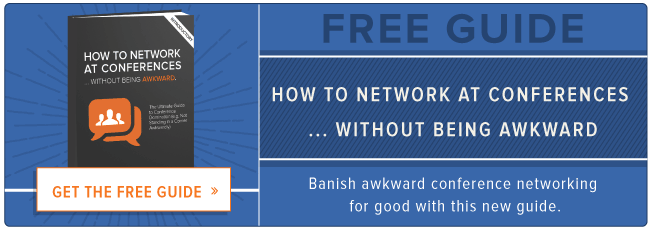Attending an inspiring conference session can often elicit a response similar to that of getting off an exhilarating roller coaster.

You're pumped. Excited. You're reviewing every twist and turn with your fellow riders with pure joy. You may even want to ride again.
Those who were with you get it. They're believers. However, to an onlooker, you all look like a hot mess shouting incoherently.
This whirlwind of emotions can oftentimes make your team members who weren't present feel like the latter. "What does he mean we have to implement all these new things, like ... yesterday?"
Don't afflict your team -- or those working under you -- with post-conference stress disorder. With so many great sessions and speakers like Arianna Huffington (are you kidding me?) lined for INBOUND, which is just around the corner, it's important to develop a plan for implementing all the awesome knowledge you learn at the events you attend. Otherwise, you risk overwhelming your team and implementing nothing at all. Here's how to do it right.
Keep Your Team Informed
If you're looking for the most effective way to kill office morale, by all means, stroll in the Monday after a conference and rave about all the changes that need to be implemented immediately.
Stress, anger, and confusion very rarely lead to an environment conducive to implementing change.
Change needs to be understood before any action can occur, and it needs to be collaborative as much as possible.
This is Inbound 101.
If key members of your team were in attendance, organize a meeting -- preferably upon returning from the conference -- during which session takeaways can be discussed and ideas can be tossed around in order to identify what has the potential to stick. Consider what you actually have the capacity to handle and implement soon.
For team members who weren't in attendance, point them in the direction of session recordings from the conference so they can directly experience what you did. Many conferences offer recordings of their sessions after the conference is over. On the off chance that recordings aren't available, make sure you're taking detailed notes during sessions in order to provide a summary of what you learned (and why it's important) to the rest of your team.
The Three R's of Implementation
So you're all pumped up after an amazing conference session. Prior to revamping your entire company's strategy, take some time to do some critical thinking before your first meeting. Sit down and run any ideas and takeaways through the three R's of implementation to determine which ones should be brought to the table at the next company meeting.
1) Relevant
Identify which elements of a session are applicable to your company and, more importantly, its resources.
Consider the varying audience in attendance. Chances are that whatever conference you're attending features anyone from startups to fortune 500 companies.
A conference speaker knows the audience, and therefore tailors his or her talking points to cover all the bases. The key is to identify at which point during the session they're speaking to you.
To help with this, create a buyer persona for yourself prior to attending a conference. This may sound silly, but it's effective. Consider these few questions in particular:
- Who are you?
- What affects your purchasing behavior?
- What are your strengths, weaknesses, and goals?
From a business standpoint, having clarity in regard to exactly who you are will help you to better understand when you’re being spoken to and which tips are more applicable.
2) Realistic
Unrealistic goals and strategies are as debilitating as not having any at all. Just because you may have learned that companies that blog twice daily generate more website traffic doesn't mean you should boost your content volume starting Monday morning.
This sounds obvious, but it’s also painfully common. Many times, C-level executives are guilty of being out of touch with the resources and time a particular strategy can take to implement and complete. Do you know how long it takes to write a fully optimized, high-quality blog post or ebook? Are you aware of the best practices for posting and engaging on Twitter to generate an ROI?
Don't envision the ends without first considering the means.
Interview your team. What are they capable of right now? In what areas could they be more efficient? What would they need in order to successfully implement additional tactics?
Work together in order to determine, realistically, what can be implemented as well as a timetable for doing so. Review and address the challenges they envision moving forward with any of these new ideas.
3) Refined
Even a cup of coffee needs a little refinement before it's ready for us to enjoy. (For most of us, anyway.) Cream only? Light and sweet? Skim and Splenda?
The same goes for any strategic advice learned from great conference sessions. Once you have an idea of what you're capable of, and your team is on board, how can it be refined in order to be consistent with your current marketing efforts?
Consider the strengths and capabilities of your team, and tailor any new strategies and tactics around them. Recycling what came from a speaker’s mouth -- as valuable as it may be -- and simply implementing it at face value is a fruitless endeavor. Introduce context. How can this apply to your company’s current strategy based on your experiences?
Develop the Process
Once you have buy-in from your team and are in agreement over the three R's of implementation, develop a process for actually implementing what you've learned successfully, smoothly, and with as little frustration and push back as possible.
Your process should be:
- Collaborative: Talk to the people it will affect the most regarding how it should be carried out. Trust their opinion. They do it every day.
- Resourceful: Include supplemental tools for the process to assist in its execution. (e.g. editorial calendars for ensuring a higher volume of content).
- Standardized: Map out the steps clearly in order to ensure a repeatable process.
Structure and communication will go miles in ensuring your team invests in any new strategies or tactics being implemented. Simply strolling into the office and rattling off a to do list to your managers isn’t a process. It’s severely counterproductive.
Anticipate a Transition
Just like with anything new, allow time for both your team to adjust -- and your audience to respond -- to these new strategies, tactics, or methodologies. Being overly zealous will only amplify any reservations or frustrations your team may already be feeling about these new initiatives.
Give the water time to saturate the soil.
This is a guest post by John Bonini (@Bonini84), marketing director at IMPACT Branding & Design. Visit the IMPACT Blog for more content from John and the agency.
Image Credit: Upsilon Andromedae










